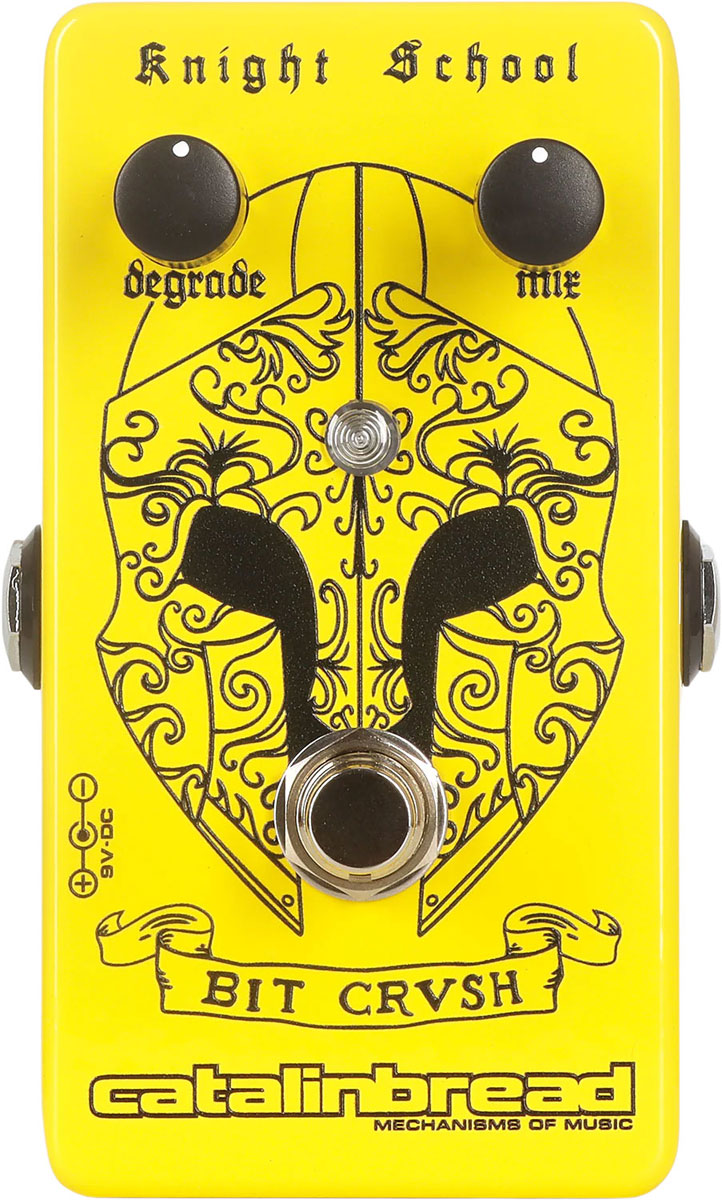KNIGHT SCHOOL BIT CRUSH - KIT PARA MONTAR
Durante mucho tiempo utilizado como truco en estudios, el bitcrushing (o reducción de la tasa de muestreo, aunque ambos son diferentes) es un efecto relativamente nuevo que toma instantáneas de tu señal de entrada y las « aproxima » con cada vez menos precisión a medida que se intensifica el efecto. Mientras que hace apenas diez años era prácticamente desconocido, este efecto ahora está integrado en muchos sintetizadores y dispositivos de procesamiento externos modernos. En resumen, le da a tu guitarra o a cualquier otro instrumento un sonido que recuerda a los videojuegos de la vieja escuela. Hemos mejorado este efecto añadiendo una función sencilla: el modesto control Mix. Gracias a él, puedes usar nuestro kit Bitcrusher para destruir tu señal tanto como quieras con solo girar una perilla. Puedes usar el Bitcrusher como procesador para otros efectos, añadiéndolo ligeramente para obtener texturas únicas y sorprendentes, o en gran cantidad para una destrucción total. En la era de los efectos para guitarra, el « bitcrushing » y la « reducción de la tasa de muestreo » son de los más recientes. A pesar de su uso funky y poco común, incluso los moduladores en anillo estaban disponibles en los años 60. Sin embargo, el bitcrushing y la reducción de la tasa de muestreo son subproductos distintos de la tecnología digital, más específicamente relacionados con errores de cuantificación en diferentes ejes. De cualquier modo, ambos términos se han confundido durante años, pero ninguno de estos nombres apareció naturalmente en las primeras iteraciones de estos efectos. La DigiTech Space Station llamó a su programa de reducción de la tasa de muestreo « Pixelator ». Otro ejemplo temprano, el Alesis Bitrman, lo llama « Decimator ». Aunque el bitcrushing implica una reducción de la profundidad de bits de la señal, es el reductor de frecuencia de muestreo el que evoca los sonidos más asociados a los videojuegos de los años 80, y por ello este término se ha confundido con el concepto de bitcrushing, hasta el punto de que muchos entusiastas del equipo usan ambos términos de manera intercambiable y no ven problema en ello. Es como en Texas, donde « Coke » en un restaurante puede referirse a cualquier tipo de refresco. No estoy de acuerdo con ninguno de los dos, pero el público ha ganado. Entonces, ¿cómo suena realmente? Bueno, la reducción de la frecuencia de muestreo toma « instantáneas » de la señal de entrada a una frecuencia alta, luego baja la frecuencia a la que se toman estas instantáneas a un rango audible para que podamos escucharlas. Cada una de estas instantáneas (las sumas de Riemann para los matemáticos) se amplía a medida que la tasa de muestreo disminuye, formando una « aproximación escalonada » de la señal de entrada. Cuanto más baja es la frecuencia de muestreo, más « pixelada » parece la forma de onda, lo que probablemente explica por qué DigiTech eligió el nombre del programa en la estación espacial. De cualquier modo, me recuerda a los juegos de Atari. Nuestro kit Bitcrusher está basado en el motor de una de nuestras pedales old school, la Heliotrope, que a su vez fue una adaptación de un antiguo proyecto DIY, llamado (con razón) « analog bit crusher ». Si hay un efecto que necesita control de mezcla, es este. Y sorprendentemente, muchas pedales que hacen esto no lo ofrecen. Nosotros sí, y el resultado es un efecto absolutamente genial. Conecta otras pedales para obtener un sonido fuera de lo común que no encontrarás en ningún otro lugar.
Características:
- Degrade: este botón controla la frecuencia de muestreo. Cuando está completamente bajado, la frecuencia de muestreo no está en el rango audible, por lo que no se oye ningún efecto. Al subir ligeramente el control, introduces cierto aliasing digital. Según la posición del botón, las « instantáneas » son lo suficientemente pequeñas como para provocar « errores de nota ». Por lo tanto, no intentes afinar tu guitarra con esta función activada. En su máximo, la señal está completamente destruida, como si fuera triturada en Asteroids. NOTA: la configuración original del esquema DIY y de nuestra Heliotrope produce un ligero « ruido de siseo » de fondo. Para este kit, se han tomado muchas medidas para atenuar este ruido, que es claramente menos fuerte que en los modelos originales. Sin embargo, sigue presente, aunque más discreto. Cuando el botón está completamente bajado, solo se escucha la señal seca. Cuando está completamente subido, solo se escucha el efecto. Cualquier posición intermedia corresponde a una mezcla igual. La posición media corresponde a una mezcla 50/50. Cuando usas otras pedales antes de este dispositivo, por ejemplo una pedal fuzz, esta se convierte en la señal seca en la configuración wet-dry. Así, al ajustar este botón en medio, obtienes mitad fuzz, mitad fuzz submuestreado. Alimentación eléctrica El Knight School Bit Crush acepta únicamente alimentación CC con polaridad negativa en el centro capaz de suministrar 9 voltios. Información sobre el kit DIY La placa de circuito impreso tiene etiquetas que indican la ubicación de cada componente. La imagen a continuación te será muy útil para identificar los diferentes componentes. También encontrarás un video más abajo que te muestra cómo proceder.
 es
es 